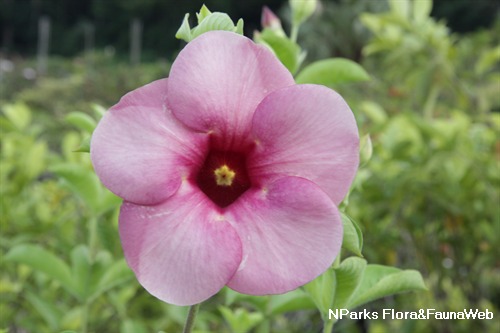
Name
Classifications and Characteristics
| Plant Division | Angiosperms (Flowering Seed Plants) (Dicotyledon) |
|---|---|
| Plant Growth Form | Shrub, Climber |
| Lifespan (in Singapore) | Perennial |
| Mode of Nutrition | Autotrophic |
Biogeography
| Native Distribution | Brazil |
|---|---|
| Native Habitat | Terrestrial |
| Local Conservation Status | Non-native |
Description and Ethnobotany
| Growth Form | It is an evergreen shrub that grows up to 2.5 m height with many branches. |
|---|---|
| Foliage | Leaves are light green, measuring up to 10 cm long and elliptical in shape, with pointed leaf tip (acuminate). |
| Flowers | Bright yellow, trumpet-shaped flowers are 5 cm wide and 5 cm long. |
| Fruit | The fruit is a spiny, round seedpod that turns from green to brown at maturity, measuring about 5 cm in diameter. The fruit opens to expose many flat seeds. |
| Similar | This species is similar to Allamanda cathartica var. hendersonii, but it has a shrub-like growth form instead of a vining growth form and its flowers are half the size of the latter. |
| Taxonomy | The historical spelling of Allamanda oenotheraefolia has been corrected to Allamanda oenotherifolia. |
| Cultivation | Grow under sun with rich, well-drained soil. It can be pruned to shape and adaptable to bonsai pruning. |
| Etymology | The genus Allamanda is named after Jean Allamand, an 18th century Dutch naturalist who is a specialist in the flora of Brazil. The specific epithet oenotheraefolia comes from Oenothera which is a group of plants collectively known as evening primrose, and folium meaning leaf, which refers to the similarity of Allamanda foliage to the evening primrose. |
Landscaping Features
| Desirable Plant Features | Ornamental Flowers, Ornamental Fruits |
|---|---|
| Landscape Uses | Parks & Gardens, Small Gardens, Hedge / Screening, Focal Plant, Container Planting, Suitable for Bonsai |
Plant Care and Propagation
| Light Preference | Full Sun |
|---|---|
| Water Preference | Moderate Water |
| Plant Growth Rate | Moderate |
| Rootzone Tolerance | Moist Soils, Well-Drained Soils, Fertile Loamy Soils |
| Transplanting Tolerance | Moderate |
| Maintenance Requirements | Moderate |
| Pruning | Can be vigorously pruned to shape for bonsai, or to remove dead or damaged branches. |
| Potential Problems | Mealy bugs. Use white summer oil or neem oil. |
| Pest(s) | Sucking Insects |
| Propagation Method | Seed, Stem Cutting |
Foliar
| Foliage Retention | Evergreen |
|---|---|
| Mature Foliage Colour(s) | Green |
| Mature Foliage Texture(s) | Glossy / Shiny, Leathery |
| Prominent Young Flush Colour(s) | Green |
| Young Flush Texture(s) | Leathery |
| Foliar Type | Simple / Unifoliate |
| Foliar Arrangement Along Stem | Whorled |
| Foliar Attachment to Stem | Sessile |
| Foliar Shape(s) | Non-Palm Foliage (Elliptical) |
| Foliar Venation | Pinnate / Net |
| Foliar Margin | Entire |
| Foliar Apex - Tip | Acuminate |
| Foliar Base | Acute |
Floral (Angiosperm)
| Flower Colour(s) | Yellow / Golden |
|---|---|
| Flower Texture(s) | Smooth |
| Flower Grouping | Cluster / Inflorescence |
| Flower Location | Axillary |
| Flower Symmetry | Radial |
| Individual Flower Shape | Trumpet-shaped |
| Flowering Period | Free-Flowering |
Fruit, Seed and Spore
| Mature Fruit Colour(s) | Brown |
|---|---|
| Mature Fruit Texture(s) | Thorny / Spiny |
| Fruit Classification | Simple Fruit |
| Fruit Type |
Image Repository
Others
| Master ID | 12 |
|---|---|
| Species ID | 1308 |
| Flora Disclaimer | The information in this website has been compiled from reliable sources, such as reference works on medicinal plants. It is not a substitute for medical advice or treatment and NParks does not purport to provide any medical advice. Readers should always consult his/her physician before using or consuming a plant for medicinal purposes. |














